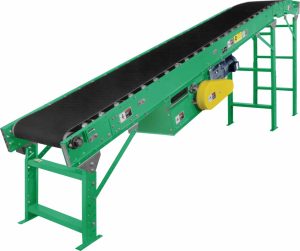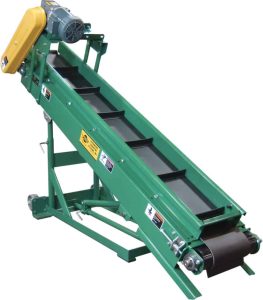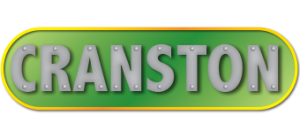Incline Conveyors
Incline conveyors are the workhorses of vertical transport, seamlessly carrying goods between different levels without breaking a sweat. Whether you’re tackling mountains of boxes in a warehouse, navigating multi-story production lines, or even managing baggage at an airport, an incline conveyor can be your reliable partner in conquering those logistical heights.
What are Incline Conveyors?
Imagine a conventional conveyor belt, tilted upwards. That’s essentially an incline conveyor! They come in various configurations, utilizing belts, rollers, or chains to efficiently move goods at an angle. These versatile systems can handle diverse terrains, making them invaluable for overcoming elevation challenges in various industries.


Types of Incline Conveyors:
- Belt Conveyors: Popular for versatility and high capacity, featuring cleats or textured surfaces for added grip.
- Roller Conveyors: Cost-effective for lighter loads and shorter inclines, offering smooth product movement.
- Chain Conveyors: Ideal for heavy-duty applications and steeper inclines, providing robust and reliable transport.
- Spiral Conveyors: Compact and space-saving, ideal for multi-level operations with limited floor space.
Benefits of Using Incline Conveyors:
- Efficient Elevation: Effortlessly move goods between different levels, saving time and labor.
- Space Optimization: Utilize vertical space effectively, maximizing footprint utilization in your facility.
- Improved Workflow: Automate product movement, boosting overall efficiency and productivity.
- Reduced Labor Costs: Minimize reliance on manual lifting and carrying, potentially reducing injuries and strain.
- Wide Application: Versatile across various industries, from manufacturing and warehousing to airports and food processing.
Choosing the Right Incline Conveyor:
Selecting the perfect incline conveyor for your needs requires careful consideration of several factors:
- Type and weight of goods: Ensure the conveyor can handle the specific weight and dimensions of your products.
- Inclination angle: Choose a system that accommodates your desired incline for optimal performance.
- Throughput volume: Select a conveyor with sufficient capacity to handle your daily or peak processing needs.
- Layout and space constraints: Opt for a conveyor that integrates seamlessly into your existing facility layout.
- Budget: Consider the initial investment and ongoing maintenance costs.
Get A Proposal
Additional Considerations:
- Safety features: Look for emergency stops, guardrails, and slip-resistant surfaces to ensure operator safety.
- Material considerations: Choose materials suitable for your environment and potential exposure to moisture, dust, or other elements.
- Maintenance requirements: Select a conveyor with easily accessible components for routine maintenance and cleaning.
Invest in Vertical Efficiency with Incline Conveyors
By implementing the right incline conveyor system, you can improve operations, efficiencies and profitability. From streamlined vertical product movement and optimized space utilization to improved efficiency and reduced costs, incline conveyors offer a smart investment for businesses tackling elevation challenges.
Ready to reach new heights? Contact Cranston Material Handling today to discuss your specific needs and learn how an incline conveyor can meet your productivity vision.





